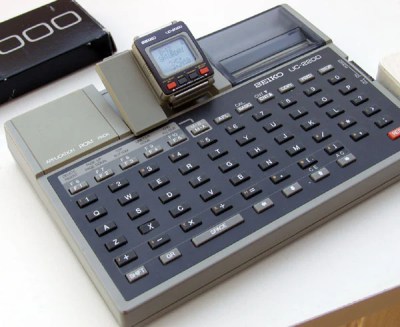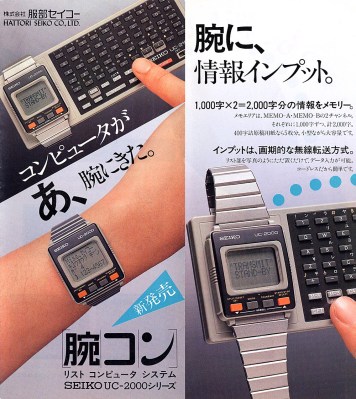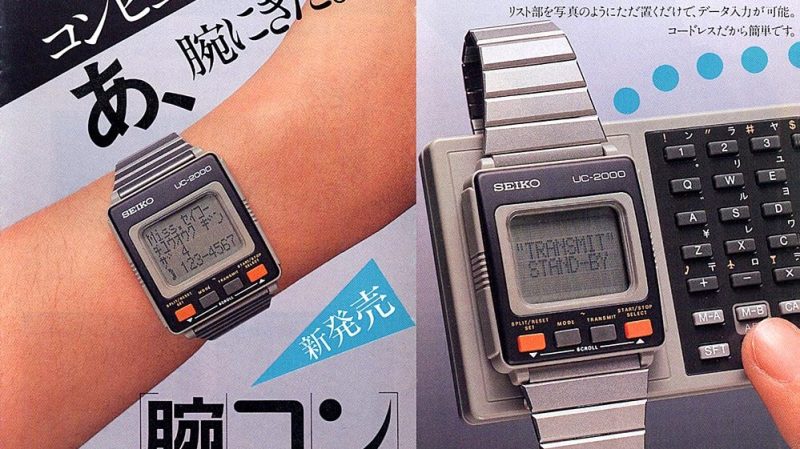You might think of the smartwatch era as beginning with Apple, relatively recently. Or, you might think back to those fancy Timex models with the datalink thing going on in the 1990s. Seiko can beat them all, though, with its UC-2000 smartwatch that debuted all the way back in 1984.

The UC-2000 very much looks cutting edge for its era, and absolutely ancient today. It featured a 4-bit CPU, 2 kilobytes of RAM, and 6 kilobytes of ROM. Display was via a simple 10×4 character LCD in a rectangular form factor, with four buttons along the bottom. Branded as a “personal information processor,” it was intended for use with the UC-2100 dock. This added a full physical QWERTY keyboard that interacted with the UC-2000 when the two were combined together. Alternatively, you could go for the UC-2200, which not only had a keyboard but also a thermal printer to boot. Oh, and ROM packs for Microsoft Basic, games, or an English-to-Japanese translator.
 What could you do on this thing? Well, it had basic watch functions, so it told the time, acted as a stop watch, and an alarm, of course. But you could also use it to store two memos of up to 1000 characters each, schedule appointments, and do basic calculations.
What could you do on this thing? Well, it had basic watch functions, so it told the time, acted as a stop watch, and an alarm, of course. But you could also use it to store two memos of up to 1000 characters each, schedule appointments, and do basic calculations.
The one thing this smartwatch was missing? Connectivity. It couldn’t get on the Internet, nor could it snatch data from the ether via radio or any other method. By today’s measures, it wouldn’t qualify as much of a smartwatch at all. Moreso a personal organizer that fit on the wrist. Still, for its day, this thing really was a whole computer that fit on your wrist.
Would you believe we’ve seen the UC-2000 before? In fact, we’ve even seen it hacked to play Tetris! Video of that wonderful feat after the break.
















I am quite impressed with that. I had the Timex DataLink circa 1995, but this looks fantastic at a decade earlier.
In 1977 I built a Sinclair calculator watch from a kit https://planetsinclair.meulie.net/calculators/wristcalc.htm, I thought aged 13 it made me look very smart.
When on the 2200 base station, the watch is simply a display and does no processing. If the application in the ROM pack is small enough it can be transferred to the watch, replacing the RAM occupied by memos, and memo functions are disabled. Things written in BASIC cannot be transferred, they only reside and run on the base station using the watch as an output device (monitor)
It feels unreal that this is from same year the original Macintosh came out (followed by Atari ST not much later).
On the other hand, the ancient display is still more capable than what most electronic organizers had offered here in western Europe up until ~2000.
Palm Pilots and similar sophisticated PDAs excepted, of course.
The display and its power source might be most relevant piece here, really.
The fact that it can display simplified Japanese characters is still something, I think.
The 4-Bit microcontroller and the tiny RAM are cute, at best, I think.
Might have been better used as heart of a datalogger or weather station. Or a washing machine.
Managers were quite demanding when it comes to a organizer functionality, I mean.
The smart watch as shown surely was a nice gadget, but without plenty of storage memory it was little more than a novelty in real life.
but … can it run doom?
At the time, Japan was about to take over the world. The fix was soon to be implemented by the usual suspects, with the property bubble.
Yup. Now it’s China. And since Europe never had played much of a role in computing, nothing is lost here.
Okay, we had weird companies like Sinclair, Acorn, Olivetti and Thompson who made computers, but nothing that big.
The US by contrast has lost a lot of relevance, too, just like Japan had.
It’s now all about media control (Google, FB, Twitter/X,) and badly written software, I think.
I often think it’s sad what Silicon Valley had turned into. Lots of hype, with little of substance.
In this hindsight, I sometimes think to myself that maybe it’s good that Japan is out of the game now.
The country can now focus more on different things, maybe and the own little world.
As a result, its part of internet had remained “sane”, mostly.
Japanese websites often look still “normal”, like they did in the pre-Facebook era, with lots of information and without minimalism. But that’s another story, maybe.
Yeah, nothing has gotten much better since the 1980s other than some medical procedures and endless ouroboros navel-gazing internet and cell phone stuff, giving everybody phone neck. The electric cars are better too
From little Acorn did a mighty ARM grow!
What protocol is used to allow the communication between the watch and the dock? Is it infrared?
Hi, I tried to find sime information, but I’ve merely found something about the Seiko Data 2000 (1983); maybe a predecessor?
“How does it work? This is interesting part: data is transmitted via “electromagnetic coupling”. There’s a small metal loop in the watch and another in the keyboard. Current flows through the loops, turning each into a magnet. Communication occurs via a series of magnetic pulses from each side. Data is transferred (2,048 bits/second with a ~32 KHz carrier frequency) and the watch receives the data for storage.”
https://raredigitalwatches.com/seikorc.htm
I forgot to mention, there’s an 32,768kHz frequency used by quartz crystals.
It’s often being used by crystal-controlled watches/clocks.
It’s maybe being related to this.
Thanks, this is very interesting. so the back of the watch is plastic and not metal to allow the communication through electromagnetism?
We’re looking for way to upload to/download from Sensor watch which is a custom motberboard for a Casio F-91W and this kind of communication could be used.
So it does have radio connectivity, just very short-range
Induction. Fun fact: the speaker in your phone is enough to communicate and there is even an app to produce clicks with the correct timing: UC-2000 Keyboard (android)
And by this I mean it’s not the sounds, but the voice coils’ electromagnetic pulses
A thing of lust for a geek in 1984. I wanted one at the time. Just like the original Macintosh that came out the same year, it was stupidly expensive and fundamentally useless, but I still wanted one.
Humm? Not a big deal seven years after the HP-01!!!
I had that thing and also the later Casio DataBank. Awesome stuff for the 80’s. Now if I could just find them again and go retro…
Nothing began with Apple since the 80’s.
Everything began with Apple 2 in the 70s?
And I thought the wrist watch + calculator was cool. At one or two of those when they were in vogue.
Wasn’t aware of the above wrist device…. Neat!
Amazing, I see you can still buy wrist watch calculators on Amazon. Might have to pop for one again for nostalgia sake. If memory serves, mine were back in the early 80s during high school. The cool geek device… Moved on to HP-11/15/16 while in college as more practical for the time.
There had been early TV watches, too.
And wrist watches with LCD games and melodies (music box).
Some wrist watch calculators had them, too.
This dates back to the mid-late 70s, I think.
Shortly after wrist watches with red 7-segment LEDs appeared, I think.
Funny, I was chatting with some people about the Fairlight CMI and remembered the first time I saw one was on Sesame Street when Herbie Hancock was demonstrating it. Went to find and share that video and noticed he was wearing this watch in that segment.
“You might think of the smartwatch era as beginning with Apple”
Well, I’d think it began with Pebble, 2 years before the Apple watch.
But I would rather argue that the Epson RC-20 from 1984 is the first proper smartwatch, with a Z80 (compatible) processor, 2K ram and 8K rom, and having the possibility to upload user-programs. Wish I had one of those. :'(
The Seiko RC-1000 is imo not a smartwatch but a databank.
Someone wrote a T-Rex game for the Epson RC-20. :D
https://www.youtube.com/watch?v=gIUXOaXoHQo
Ok, to give Seiko some deserved kudos: Seiko’s and Epson’s smartwatches and databank watches were created in collaboration, so the Seiko RC-1000 series is as much an Epson as the Epson RC-20 is a Seiko. ;)
A Z80? Let’s imagine it had a miniature CP/M clone in ROM. That would have been awesome!
If it had 8KB of RAM, simple standard CP/M applications might have run already.
I have a Sony Ericson LiveView, which I consider the first modern smartwatch: Bluetooth connected to show notifications from an Android smartphone. They eventually followed it up with the Sony SmartWatch, around the same time as the Pebble.
Those were the days my friends, today’s gadgets are boring.
I seem to remember seeing one of these in a DAK catalogue way back in the 80’s. Either this or something very much like it. What a great time to be alive!
I had one of these, and the best thing I did with it was to make a flip-book ASCII-art animation. You’d hold down the page scroll button to watch it.